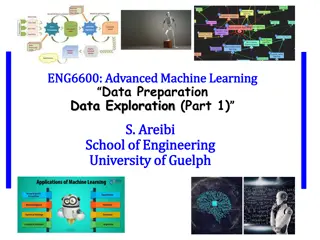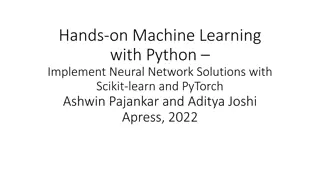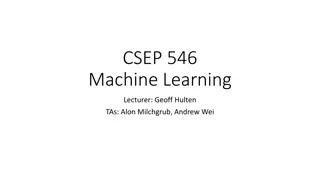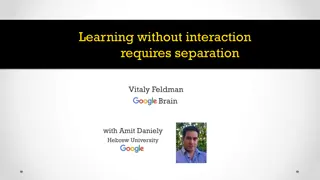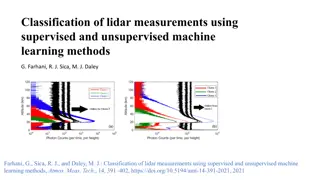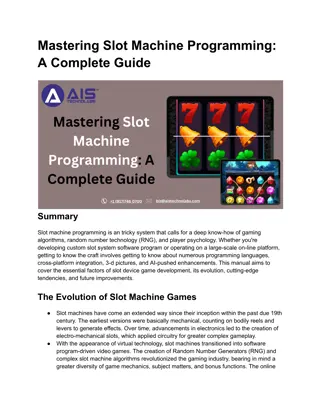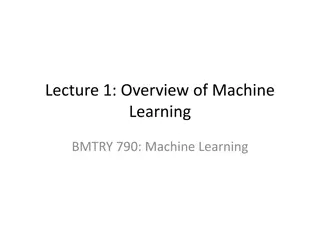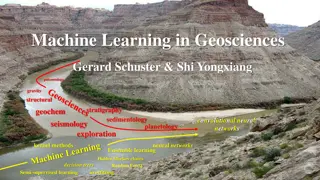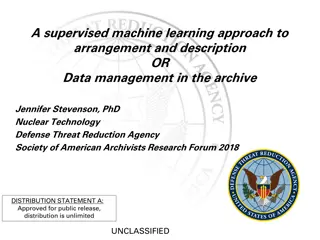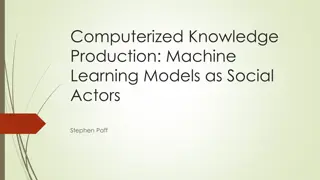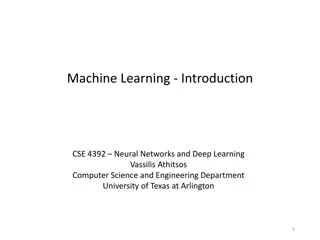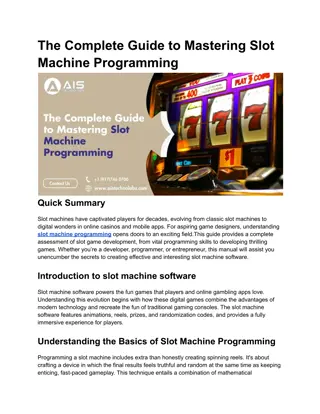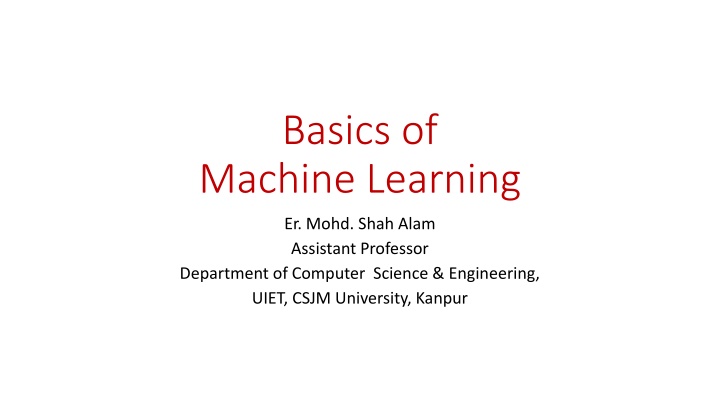
Essentials of Machine Learning and Its Characteristics
"Explore the fundamentals of Machine Learning, including its definition, differences from traditional programming, key characteristics, advantages, disadvantages, and various applications. Understand how Machine Learning enables computers to learn and make predictions based on data. Discover the potential and challenges of this innovative field."
Download Presentation

Please find below an Image/Link to download the presentation.
The content on the website is provided AS IS for your information and personal use only. It may not be sold, licensed, or shared on other websites without obtaining consent from the author. If you encounter any issues during the download, it is possible that the publisher has removed the file from their server.
You are allowed to download the files provided on this website for personal or commercial use, subject to the condition that they are used lawfully. All files are the property of their respective owners.
The content on the website is provided AS IS for your information and personal use only. It may not be sold, licensed, or shared on other websites without obtaining consent from the author.
E N D
Presentation Transcript
Basics of Machine Learning Er. Mohd. Shah Alam Assistant Professor Department of Computer Science & Engineering, UIET, CSJM University, Kanpur
Agenda What is Machine Learning? How Machine learning is differ from Traditional Programming? Characteristics of Machine Learning. Advantages of Machine Learning. Disadvantages of Machine Learning. Classification of Machine Learning. Carrier opportunities. Pre-requisites.
Machine Learning is Machine learning is the science of getting computers to learn and act like humans do, and improve their learning over time in autonomous fashion, by feeding them data and information in the form of observation and real world interaction.
Machine Learning is Machine learning is about predicting the future based on the past. -- Hal Daume III past future predict Training Data Testing Data model/ predictor model/ predictor
Machine learning is differ from Traditional Programming Traditional Programming input Data Program It is manual process. Programar build the program. If you want to square of a number then you give data that is number output Computer
Machine Learning input Data output Computer Program
Characteristics of Machine Learning The potential to perform data Visualization(pictorial/graphical representation) Precise data Analysis Business intelligence at its finest
Advantages of Machine Learning Resolving Complex Problem Automation for everything-it is powerful utility of machine learning ex. Chatbot Trends and pattern identification Wide range of application -Self driving cars -Medical Diagnosis -Image Processing - Cyber fraud Detection -Inface recognition
Disadvantages of Machine Learning Data acquisition Highly Error Prone Algorithm Selection Time Consuming
Classification of Machine Learning Supervised Learning Unsupervised Learning Reinforcement Learning
Carrier opportunities Machine Learning Engineer Business Intelligence Developer Data Scientist NLP Scientist
Pre-requisites Basic Knowledge of Python Programming Fundamental knowledge of Statistics and Probability Understanding of Linear Algebra and Calculas
Machine Learning Life Cycle Data Collection Data Prepration Data wrangling Data Modeling Model Training Model Testing Deployment
Machine Learning Life Cycle. Data Collection: Goal over here is to gather as much as relevant data as possible.. Identify various source of information Gather data Combine the data acquired from various data source
Machine Learning Life Cycle Data Prepration: data prepration deals with exploration of your data to generate for better results Data wrangling: data wrangling is the process of cleaning raw data into useable format. Some steps includes.. - Filtering/cleaning up of raw data - Filtering noise - Recognizing and removing outliers( remove abnormal readings) - Removing or Filling the missing values
Machine Learning Life Cycle Data Modeling: Data Modeling is the step in which we take the data and select a machine learning algorithms to build a model based on the problems such as classification, regression, clustering etc. Model Training: Machine Learning model is a process in which a machine learning algorithm is fed with sufficient training data to learn from Model Verification: This stage of machine learning life cycle involves checking for the accuracy of the model by Providing with the inputs that are unseen Model Deployment: this is the final step in this model is ready to go to production.
Best languages for the Machine learning Python Java R Java Script Scala
Types of Machine learning 1. Supervised learning 2. Unsupervised learning a) b) Classification Regression 3. Reinforcement learning a) b) Clustering Association Analysis
Supervised learning Also called the predictive learning. A machine predicts the class of unknown objects based on prior class-related information of similar objects Labelled Dataset Output is already known Machine is fed with lots of input data Model is build based on training data to predict the outcomes
Supervised learning Classification: predict class from observations The main goal of classification is to predict the target class. If the trained model is for predicting any of two target classes. It is known as binary classification. Considering the student profile to predict whether the student will pass or fail. Considering the customer, transaction details to predict whether he will buy the new product or not. If we have to predict more the two target classes it is known as multi- classification. Considering all subject details of a student to predict which subject the student will score more..
Some popular machine Learning algorithms which helps to solve classification problems Na ve Bayes Decision Tree K-Nearest Neighbour
Some typical classification problems Image classification Prediction of disease Win-loss prediction of games Prediction of natural calamity like earthquake, flood etc. Recognition of handwriting
Supervised learning Regression predict value from observations The main goal of regression algorithms is the predict the continues value. In some cases, the predicted value can be used to identify the linear relationship between the attributes. Based on the problem difference regression algorithms can be used. some of the basic regression algorithms are linear regression, polynomial regression etc Popular one is Linear regression
Typical application of regression can be seen Demand forecasting in retails Sales prediction of managers Price prediction in real estate Weather forecast Skill demand forecast in job market
Unsupervised learning In Unsupervised learning, there is no labelled training data to learn from and no prediction to be made. In this the objective is to take a dataset as input and try to find natural groupings or pattern within the data elements or record. It is referred as pattern discovery or knowledge discovery, one critical application of unsupervised learning is customer segmentation. Independent Learning process No output mapping with input Unlabelled dataset Detect hidden Patterns
Unsupervised learning Clustering: A clustering problem is where you want to discover the inherent groupings in the data, such as grouping customers by purchasing behavior. Association: An association rule learning problem is where you want to discover rules that describe large portions of your data, such as people that buy A also tend to buy B. Critical application of association analysis include market basket analysis and recommender system Some popular examples of unsupervised learning algorithms are: k-means for clustering problems. Apriori algorithm for association rule learning problems.
Market Basket Analysis trasID Items Bought 1 [butter, bread] 2 [Diaper, bread , Milk, Beer] 3 [Milk, Chiken, Beer, Diaper] 4 [Bread, Diaper, Chiken, Beer]
Cluster Analysis Finding groups of objects in data such that the objects in a group will be similar (or related) to one another and different from (or unrelated to) the objects in other groups Inter-cluster distances are maximized Intra-cluster distances are minimized
Reinforcement Learning The models learns and updates itself through reward/punishment Feedback and past experiences Long term Iterative Process More feedback More Accurate System Also called Morkov Decision process Standard Algorithms- Q-learning, sarsa Practical applications include Self Driving cars, intelligent robots


